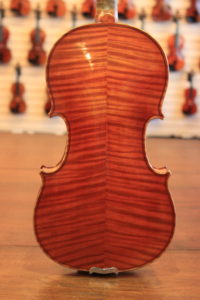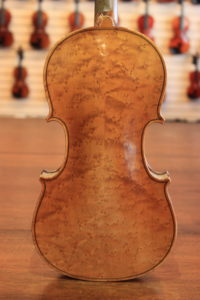Although the vast majority of violins, violas and cellos are constructed using the same species of wood they can vary greatly in appearance. The tops are always made from spruce while the ribs, back and necks are almost always made from maple. While spruce maintains a similar look among different specimens, the figure in maple can vary drastically from one instrument to the next.
There are three dominant categories of figured maple used by luthiers. The beautiful variations described below are all considered anomalies and are not completely understood. Scientists have yet to understand what causes the variations and why they appear in some trees and not others.

Flamed Maple Violin by Eliseo Secchi, Paris c.1882
Flamed Maple a.k.a. Tiger Stripe Maple a.k.a. Curly Maple:
Contrary to popular belief, flames (or curl) are not part of the wood grain. They run perpendicular to the annual rings that comprise the grain and therefore can best be described as “figure”.
During normal tree growth cells orient themselves vertically. Flames occur as the tree’s cells orient themselves in an undulating horizontal pattern. Splitting this type of wood reveals the corrugated, wavy growth and cutting through the waves reveals the striped pattern we know and love.
Once split, the wood shimmers and reflects the light back to the viewer in a way that makes it appear as though the wood is alive and moving in front of you. The dark flames turn light while the light flames turn dark. This optical illusion is called chatoyancy which is most commonly associated with “Tiger’s Eye” gemstones.
It is impossible to predict with accuracy if any given tree has curly figure in the wood. The only way to find out is to cut down the tree and split the wood. If flames are present, no more than 10% of the tree will exhibit that type of growth pattern. The scarcity mixed with beauty makes this wood extremely desirable.
Flamed maple is used by luthiers more than any other type of figured maple and it may be quarter cut or slab cut to produce different visual effects.

Birdseye Maple Violin Made in Germany c.1890
Birdseye Maple:
Despite decades of research no one has been able to truly understand birdseye maple. What causes the tiny, swirly pattern that is occasionally present in hard maple trees is still unknown. Examples of this beautiful phenomenon are found most frequently around the Great Lakes but are also found in other areas including the Rocky Mountains and in parts of Europe.
The bark of trees with birdseye figure can give clues to its presence but the tree must be felled to discover what the wood actually looks like. If the bark of a particular section of a hard maple tree appears darker, thicker and flakier in one area it may be a sign of birdseye figure in that part of the tree. Even with these indicators the tree may only posses a few swirls that are not concentrated enough to be considered suitable for instrument making. Really fine examples of tightly concentrated eyes are extremely desirable and valuable.
Birdseye maple that is suitable for lutihers is fairly scarce and may be quarter cut or slab cut.

Quilted Maple Violin Made in Belfast, ME c.1933
Quilted Maple:
Quilted maple is a distortion of the grain itself that may be described as ripples, water drops or blisters. The wood must be split along the tangential plane (slab cut) for it to be visible. As a result, instruments made with quilted maple will often have one-piece backs.
Quilted maple is significantly more rare than flamed maple. It is rated based on the depth of figure, contrast of color and consistency of the pattern. Since the figure comes from a distortion in the grain it is extremely difficult to work. When successful, instruments with quilted maple are absolutely stunning.


